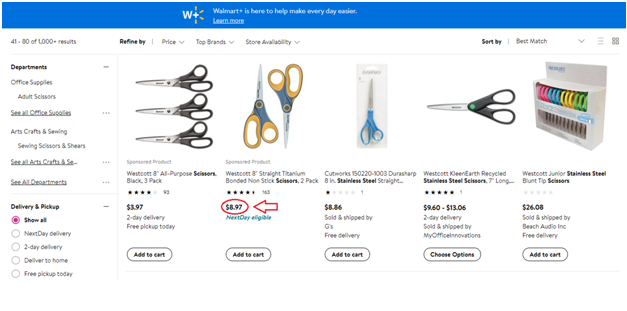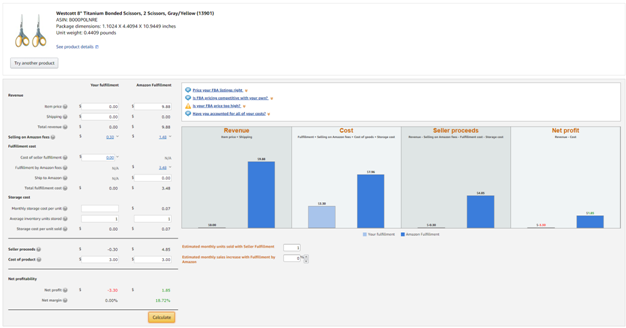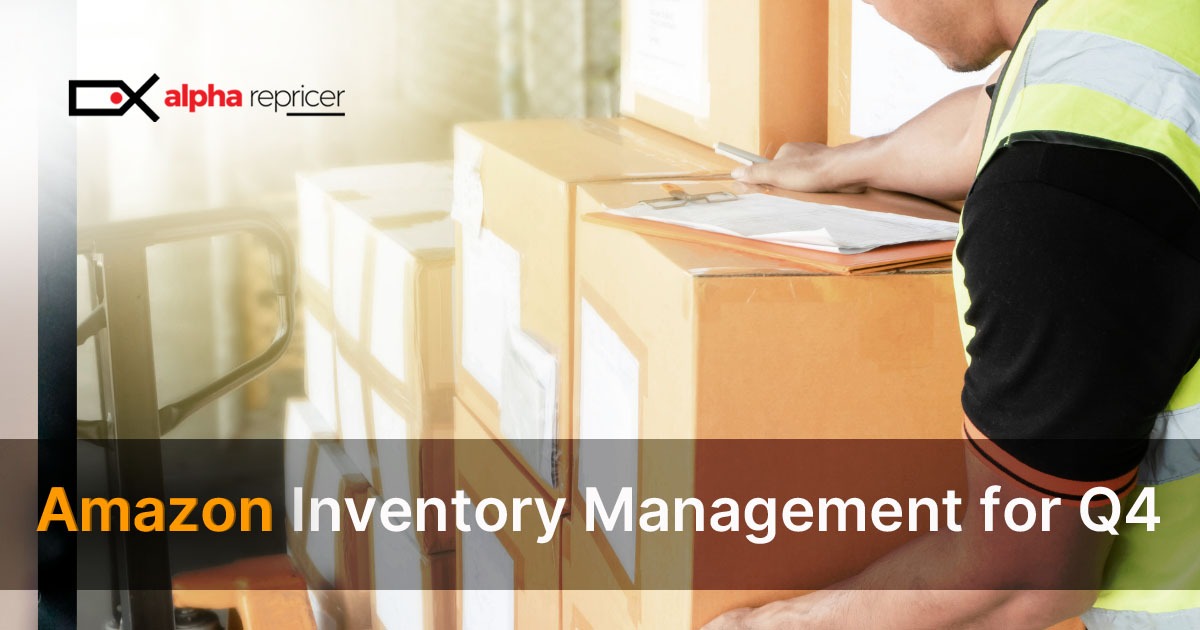Online Arbitrage on Amazon: Is It Worth It?
The brick-and-mortar business model is approaching the end of days. But, very few people are aware of the business potential and money there is to be made by selling on Amazon. More specifically, we’re referring to online arbitrage by Amazon FBA sellers. Online arbitrage requires no more than a stable internet connection, a laptop, and some basic knowledge about online selling.
Technological advancements have made it easier to sell things online. Rightfully, most people see the e-Commerce juggernaut as the best place to purchase virtually anything; but it also provides well-informed sellers with ample growth opportunities.
Consider the following statistic: According to the Bank of America, 44% of all online purchases within the United States are on Amazon, whereas 3rd party sellers are responsible for more than half of all transactions on Amazon. Do the math, and that amounts to a quarter of all e-commerce sales!
While all of this may sound too good to be true, we’re by no means pushing a “get rich quick” scheme. Online arbitrage—like any other business—requires grit, hard work, and proper guidance. By the end of this blog, we hope you’ll have the right tools needed to succeed and elevate a seemingly small side-hustle to a profitable, large-scale business.
What is Online Arbitrage, and how is it different from Retail Arbitrage?
To understand online arbitrage, we first need to know how retail or traditional arbitrage works. In retail arbitrage, sellers source items from a physical store like Walgreens or Wal-Mart and then sell at a higher price for profit. Online arbitrage follows the same pattern except that it’s online and requires sophisticated pricing tools, software, and strategies.
Online arbitrage appeals to both veterans and newbies alike because of the lack of barriers to entry, such as the need to spend a considerable amount of time acquiring a license or a certificate, as is the case with Amazon FBA Wholesale. All you need to do is open an account in different marketplaces and start selling. The following are a couple of reasons why online arbitrage is superior to retail arbitrage in 2020:
- Instead of driving around town spending hours searching in different stores, you can carry out the entire process online from the comfort of your own home.
- Software applications enable users to scan and research large quantities of data in a relatively short time.
- Considerably easy to scale.
- Products arrive at your doorstep.
Online Arbitrage vs. Other Business Models on Amazon
Amazon also enables its users to sell via other business models on its platform. Let’s go over the most popular ones:
Private Label
This is when a seller creates his/her own brand/product label by making slight changes or improvements to an existing product within a specific niche. For example, a seller can ask a manufacturer to create a higher quality car charger than the one produced by a market leader and sell it under a new/unique brand or logo. Private Label or PL is the most profitable selling method but requires the highest amount of capital.
Wholesale
Wholesale is when a seller gets into contact with a distributor or brand with extra inventory and decides to sell it on Amazon. This method also requires capital, although significantly less when compared with Private Label. Many sellers prefer to go for Wholesale after obtaining a certificate that makes them authorized sellers and prevents copyright claims.
Dropshipping
Dropshipping means that the seller purchases products from a manufacturer. The manufacturer then ships the order directly to the customer or Amazon warehouse.
Now to address the obvious question: why should we opt for online arbitrage instead of these seemingly lucrative business models? Well, according to Jungle Scout‘s “The State of the Amazon Seller” report 2020, 75% of Private Label sellers claimed they had to spend well over $1,000 to launch, whereas 50% of those engaged in arbitrage were able to do so with the same or far lesser amounts.
A Few Points to Consider
Before you jump right in, it’s worth considering a few points. First, given the nature of online businesses, you must have a certain level of technical knowledge; this is especially true when it comes to operating software and reading data. Second, unless you have software like Keepa (more to come later in the blog), there’s a possibility that prices may tank well before your inventory even reaches Amazon’s warehouse.
Sometimes, there’s ambiguity regarding matching inventory since listings can be different across different markets, and some retailers do not list UPCs (Universal Product Codes). Finally, online arbitrage doesn’t allow for the same level of profits as retail arbitrage. But considering how you can carry out the whole business online, this point hardly offsets the advantages. Online arbitrage cuts much of the cost of the number of hours you spend driving.
How Online Arbitrage Works
When selling similar products across different markets, the golden rule, obviously, is to buy low and sell high. Naturally, we’ll be looking to sell on Amazon and purchase from smaller markets that feature relatively higher discounts to pull in more customers. The most crucial concept for new sellers is understanding how to reduce risk, maintain steady yet low-profit margins, and sell consistently.
Amazon—similar to any other online marketplace—charges users a fee for selling on their platform. There are four main costs sellers have to keep in mind: the FBA cost or storage fees, capital required for initial inventory, the selling fee on Amazon, and the inbound shipping cost.
Although there is a plethora of profit calculators and handy extensions online, it’s best to use Amazon’s profit calculator to obtain the most accurate figures. Now that we’ve understood the cost breakdown let’s go over how to start selling on Amazon.
Let’s Begin
If you’ve read this far, it probably means that you’ve decided that online arbitrage is your cup of tea. The first thing you’ll need is to get your hands on an Amazon Sellers Account by signing up here. Without getting into the intricacies, our operation mode will be FBA (Fulfill by Amazon) and not FBM (Fulfill by Merchant).
The most obvious reason for using FBA is that Amazon handles the pick, pack, and shipping processes and saves us much hassle. It also takes care of everything related to customer services, repacking, and returns. Amazon charges a hefty FBA fee for each item’s sale. But then, Amazon also favors FBA sellers by awarding them a higher share of the Buy Box. Ultimately, Buy Box ownership results in higher sales.
Now that our account is up and running; here is a list of popular marketplaces from where avid FBA sellers can source products. They also feature routine discounts on numerous products:
- Wal-Mart
- JCPenney
- Walgreens
- Kohls
- Gamestop
- Shopko
- Best Buy
- Sears
- eBay (can be a blast!)
Additionally, here’s a list of product categories that remain evergreen with online arbitrage sellers:
- Home and Kitchen
- Beauty and Personal Care
- Garden and Outdoor
- Pet Supplies
- Toys and Games
- Books
- Baby
- Health, Household, and Baby
- Kitchen and Dining
- Gourmet Food
Let’s assume you’ve done a bit of online research and have visited a couple of online retailers to check which items feature the best discounts or ones that are on a clearance sale. For this purpose, we would recommend Brickseek.com mainly because it allows users to apply filters and discover the best deals at any given moment.
Let us again assume that you’ve found the following discounted product on Wal-Mart’s website.

Now, head on over to Amazon.com and find the same product. However, it will have a higher price in a lot of cases.

At this stage, we use the FBA calculator, mentioned earlier, to find the difference in price and the profit the seller is making after shipping costs and fees.

Determine the cost difference between Amazon and the online retailer. Subtract the shipping cost and fees from this amount, and you’ll know how much money you’re making per sale. If the profit is acceptable to you and worth the effort, then it’s time to start selling!
Before you decide on a product, always remember to check whether the category is gated or un-gated. Gated categories are not open to everyone, and sellers need to meet additional requirements. (Read our blog on how to get un-gated for selling toys.) It’s better to start small to reduce risks. For example, a small dimensional item, such as a pair of scissors, is a nice choice because larger items incur hefty shipping costs and storage fees. Once you manage to get the hang of things, you can move onto bigger and more financially lucrative products.
Understanding Online Arbitrage Software
After practically going through the process of online arbitrage, you might be questioning the need for software. After all, quality online arbitrage software isn’t free and may have monthly fees.
Going solo without the help of software is not a good idea. It’s a tedious task that requires many hours of sifting through potential products. Undoubtedly, advanced software can execute such processes in seconds. Plus, they offer valuable features such as price comparisons across different markets, competitor research, and data analytics.
But, before we mention a few of our favorite software. Let’s go through some of the benefits of using paid online arbitrage software.
Determine expenses to maximize profits
Selling products at high profits hinges upon a keen understanding of all the costs involved. These include Amazon FBA fees, shipping costs, purchase price, and opportunity cost, among others. Software apps help users calculate and manage costs to ensure a profit on every sale.
Discover profitable deals and niches
With marketplaces featuring millions of products for sale. And the prices changing often. Gathering information manually and processing it is virtually impossible. Premium software can do that for us. Additionally, it uncovers hidden gems, highlights the best deals, and compares prices across a myriad of online stores.
Establish Best Seller Rank (BSR) and demand for products
Sellers do not want to fill up their inventory with products that sell at low prices or fail to sell at all. Most software feature rank and price history tools that show how the BSR changes over time. Finding the BSR is crucial to identify products with strong demand and stable prices. Point to note, products with higher BSR have higher sales velocity. They result in a quicker turnover.
Gain an edge over the competition
As mentioned previously, online arbitrage is relatively new and features low barriers to entry, which results in high competition. Online sellers know the key to success is to be the first to feature products and cash in on early arrivals. Online arbitrage software, along with dropshipping automation and product hunting tools, provides users with such advantages and the ability to build early momentum.
Examples of the Best Online Arbitrage Software Available in the Market
The following are a few of the best/most comprehensive software in the market.
Keepa

Keepa is a valuable price tracking tool for Amazon that offers extensive functionality and pricing history. Its key features include:
- Item availability and price drop alerts.
- Monitor more than a billion products.
- Available as a browser extension with added functionality.
- Offers information related to price history as well as graphical representations.
- Price comparison across international Amazon markets.
Fortunately, Keepa’s basic features are free and have proven to be a good starting point for new sellers to understand how these tools work. However, access to more advanced features requires a subscription of €15 a month.
Tactical Arbitrage

One of the more popular arbitrage tools available online, Tactical Arbitrage offers the following features:
- Ability to filter products based on criteria such as sales ranking and ROI.
- Recommends the best deals and heaviest discounts across different marketplaces.
- In-depth analysis of different products and listings.
- Carry out general keyword research or search for specific niches and categories.
- Scan data from more than 1000 sourcing websites.
You can purchase Tactical arbitrage for different prices that range from $49 to $119 based on the availability of features. Currently, the online arbitrage subscription costs $70 a month.
FBA Wizard

FBA Wizard is well known for its innovative functionality and in-depth product sourcing features. It also includes the following:
- Scan through numerous private label products to discover profitable niches.
- Has a nifty fee calculator that enables users to understand expenses and profit margins.
- Flip products in both Amazon Canada and U.S markets.
- Upload wholesale and product lists to scan items based on predefined parameters.
- Understand the sales demand for different products.
FBA Wizard’s monthly subscription is $99 a month. Due to recent success and a limit placed on the number of users on the platform, you might have to wait for spaces to open up before purchasing the software.
Other well-known online arbitrage software includes names like BuyBotPro, SourceMogul, and CamelCamelCamel.
Alpha Repricer

An automated repricing tool can boost your sales. Just imagine not having to watch for price changes from your competitors. Alpha Repricing tool, the best Amazon repricer, provides a very flexible method of setting rules to reprice your items. Additionally, it provides algorithmic repricing that aggressively competes for the Buy Box. Some of the features available are:
- Win Buy Box more often, with higher prices
- Continuous repricing
- Under 2 minutes repricing
- Compete differently according to fulfillment type of competitor
- Schedule
- Upload minimum/maximum prices from other tools or Excel
- Use formulas such as ROI/Profit margin to calculate min/max on thousands of items
- 12 marketplaces going on 15
- Monthly subscriptions start at $25 for 1000 listings after a 14-day free trial.
- Reports and a lot more…..
Final Thoughts
Online arbitrage is both fun and profitable should you decide to become a serious seller. One of the Coronavirus pandemic effects has been an increase in online shopping, which opens doors for online selling. Besides the low capital needed to start online arbitrage, it’s easier now because of the software tools available. The effects of the current global pandemic have been felt across every industry, and job security is a real issue. Amidst all the financial uncertainty, it makes all the more sense to start a side business like online arbitrage. Automating repricing with Alpha Repricing tool will help you maintaining competitive prices. Who knows? You might be able to quit your 9 to 5 and embark on a whole new venture from the comfort of your own home!
Tags In






